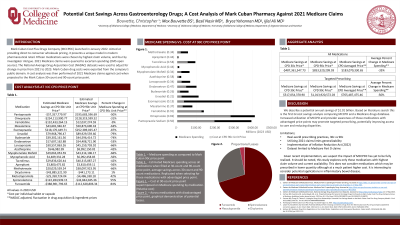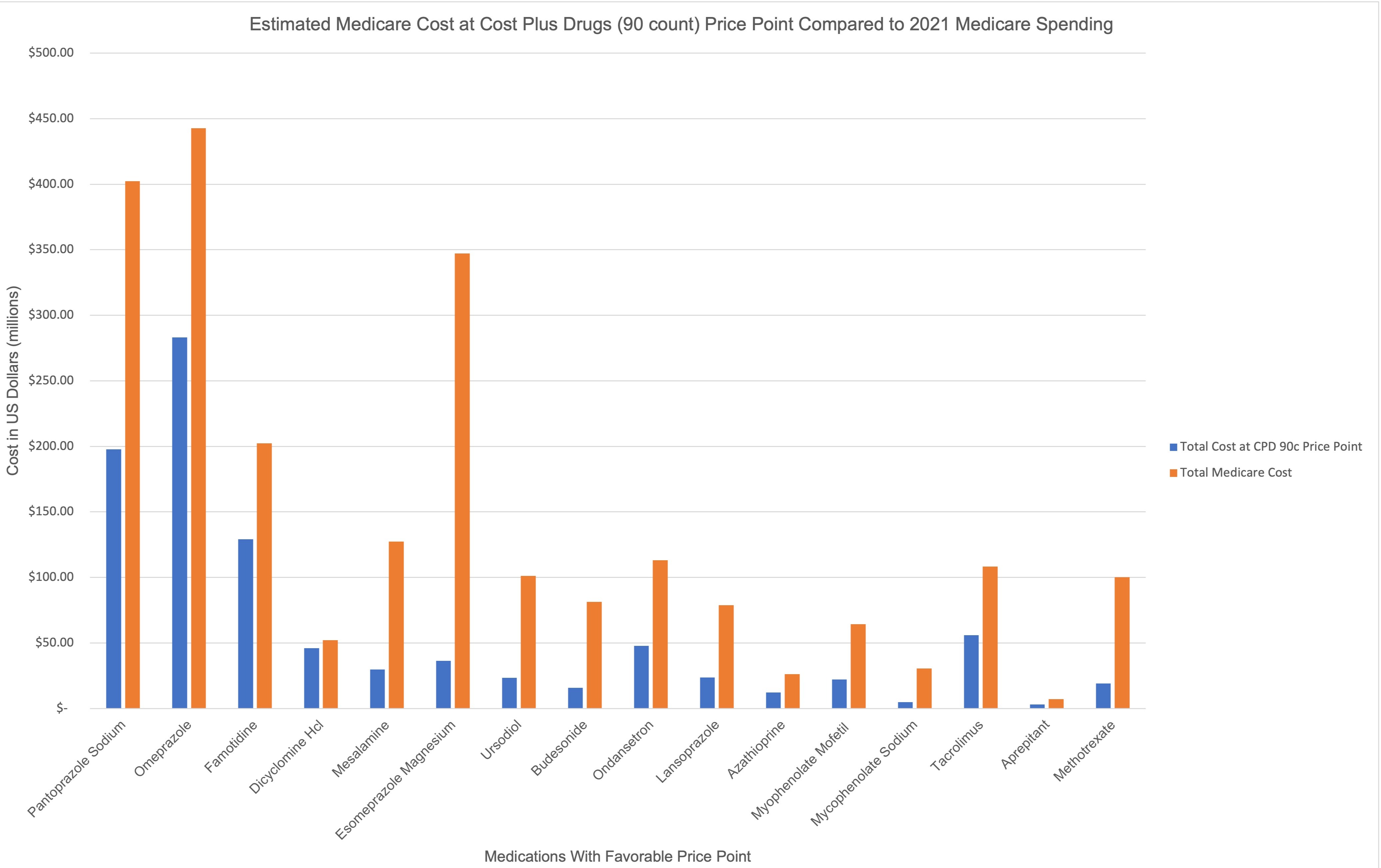Tuesday Poster Session
Category: Practice Management
P4050 - Potential Cost Savings of Targeted Prescribing Across Gastroenterological Drugs; A Cost Analysis of Mark Cuban Cost Plus Drugs Company Against 2021 Medicare Claims
Tuesday, October 24, 2023
10:30 AM - 4:00 PM PT
Location: Exhibit Hall

Has Audio
- CB
Christopher Bouvette, MD
University of Oklahoma College of Medicine
Oklahoma City, Oklahoma
Presenting Author(s)
Christopher Bouvette, MD, Max Bouvette, BS, Ahmad Basil Nasir, MD, Bryce Yohannan, MD, Ijlal A. Ali, MD
University of Oklahoma College of Medicine, Oklahoma City, OK
Introduction: Healthcare-associated costs remain a major barrier to care. Mark Cuban Cost Plus Drugs Company (MCCPDC) launched in January 2022. Aimed to provide transparent and competitive pricing, it presents an unparalleled model within pharmaceutical retail. Acknowledging the emphasis on physician stewardship, we set out to explore the potential impact of MCCPDC on gastroenterology care delivery and healthcare cost.
Methods: We queried 2021 Medicare Part D data by prescriber specialty to identify gastroenterology specific claims. We then ranked medications by claim volume. 15 drugs were available for purchase through MCCPDC and were selected for analysis (chosen by greatest claim volume). An additional four drugs (Methotrexate, Mycophenolate, Tacrolimus, and Aprepitant) were selected out of investigator curiosity. Average weighted spending per dosage unit, total number of units, and total Medicare spending across all specialties was extracted from Medicare data. MCCPDC was then used to determine a 30-count (30c) and 90-count (90c) supply cost. Regarding discrepancies in formulation or dosage within MCCPDC, the most expensive selection was made as to not overestimate any cost reduction. A cost analysis was then performed comparing CMS claims/spending against MCCPDC.
Results: Total Medicare 2021 spending was $216 billion. Across the 19 selected drugs, spending was $2.5 billion. When filled as a 30c or 90c supply through MCCPDC, projected cost was $2.7 billion (106%) and $1.3 billion respectively (53%). Furosemide, spironolactone, metoclopramide, dicyclomine, famotidine, omeprazole, and pantoprazole demonstrated a disadvantaged 30c price point (3.7, 2.2, 3.6, 1.7, 1.4, 1.5, and 1.1 relative cost). Only furosemide, spironolactone, and metoclopramide remained unfavorable when projected at the 90c price point (1.8, 1.4, and 1.5 relative cost). All other medications demonstrated significant savings, particularly at the 90c price point. When selecting for those drugs demonstrating favorable 90c relative cost, estimated savings are $1,334,576,099 (47%). (Table 1.)(Figure 1.)
Discussion: We describe a potential annual savings of $1.3 billion. Based on literature search this is the first GI cost savings analysis comparing MCCPD and a Medicare drugs database. Increased utilization of MCCPD and provider awareness of those medications with advantaged price points may promote targeted prescribing, potentially improving access to care and reducing disparities.

Disclosures:
Christopher Bouvette, MD, Max Bouvette, BS, Ahmad Basil Nasir, MD, Bryce Yohannan, MD, Ijlal A. Ali, MD. P4050 - Potential Cost Savings of Targeted Prescribing Across Gastroenterological Drugs; A Cost Analysis of Mark Cuban Cost Plus Drugs Company Against 2021 Medicare Claims, ACG 2023 Annual Scientific Meeting Abstracts. Vancouver, BC, Canada: American College of Gastroenterology.
University of Oklahoma College of Medicine, Oklahoma City, OK
Introduction: Healthcare-associated costs remain a major barrier to care. Mark Cuban Cost Plus Drugs Company (MCCPDC) launched in January 2022. Aimed to provide transparent and competitive pricing, it presents an unparalleled model within pharmaceutical retail. Acknowledging the emphasis on physician stewardship, we set out to explore the potential impact of MCCPDC on gastroenterology care delivery and healthcare cost.
Methods: We queried 2021 Medicare Part D data by prescriber specialty to identify gastroenterology specific claims. We then ranked medications by claim volume. 15 drugs were available for purchase through MCCPDC and were selected for analysis (chosen by greatest claim volume). An additional four drugs (Methotrexate, Mycophenolate, Tacrolimus, and Aprepitant) were selected out of investigator curiosity. Average weighted spending per dosage unit, total number of units, and total Medicare spending across all specialties was extracted from Medicare data. MCCPDC was then used to determine a 30-count (30c) and 90-count (90c) supply cost. Regarding discrepancies in formulation or dosage within MCCPDC, the most expensive selection was made as to not overestimate any cost reduction. A cost analysis was then performed comparing CMS claims/spending against MCCPDC.
Results: Total Medicare 2021 spending was $216 billion. Across the 19 selected drugs, spending was $2.5 billion. When filled as a 30c or 90c supply through MCCPDC, projected cost was $2.7 billion (106%) and $1.3 billion respectively (53%). Furosemide, spironolactone, metoclopramide, dicyclomine, famotidine, omeprazole, and pantoprazole demonstrated a disadvantaged 30c price point (3.7, 2.2, 3.6, 1.7, 1.4, 1.5, and 1.1 relative cost). Only furosemide, spironolactone, and metoclopramide remained unfavorable when projected at the 90c price point (1.8, 1.4, and 1.5 relative cost). All other medications demonstrated significant savings, particularly at the 90c price point. When selecting for those drugs demonstrating favorable 90c relative cost, estimated savings are $1,334,576,099 (47%). (Table 1.)(Figure 1.)
Discussion: We describe a potential annual savings of $1.3 billion. Based on literature search this is the first GI cost savings analysis comparing MCCPD and a Medicare drugs database. Increased utilization of MCCPD and provider awareness of those medications with advantaged price points may promote targeted prescribing, potentially improving access to care and reducing disparities.

Figure: Figure 1.
Disclosures:
Christopher Bouvette indicated no relevant financial relationships.
Max Bouvette indicated no relevant financial relationships.
Ahmad Basil Nasir indicated no relevant financial relationships.
Bryce Yohannan indicated no relevant financial relationships.
Ijlal Ali indicated no relevant financial relationships.
Christopher Bouvette, MD, Max Bouvette, BS, Ahmad Basil Nasir, MD, Bryce Yohannan, MD, Ijlal A. Ali, MD. P4050 - Potential Cost Savings of Targeted Prescribing Across Gastroenterological Drugs; A Cost Analysis of Mark Cuban Cost Plus Drugs Company Against 2021 Medicare Claims, ACG 2023 Annual Scientific Meeting Abstracts. Vancouver, BC, Canada: American College of Gastroenterology.
